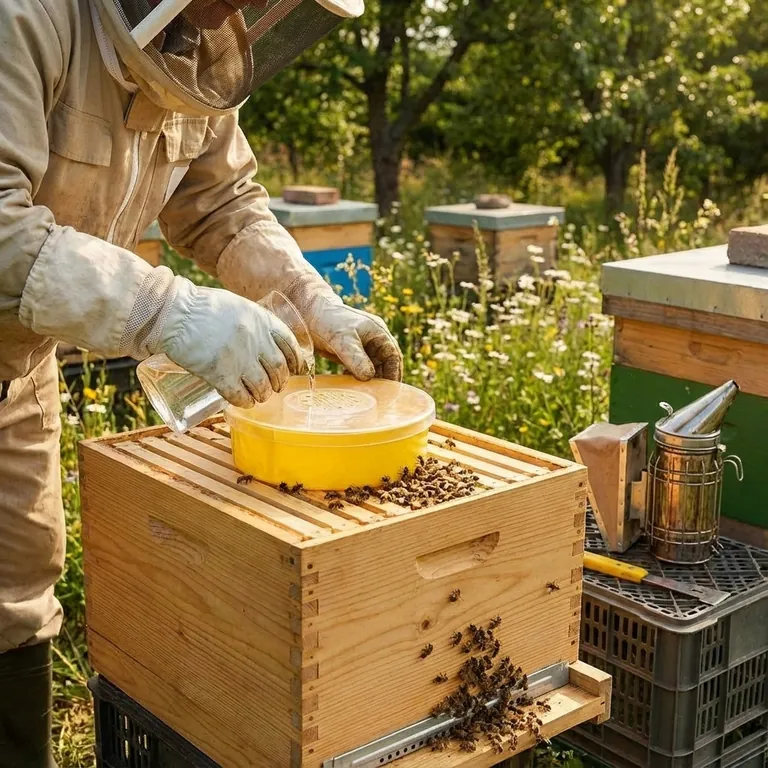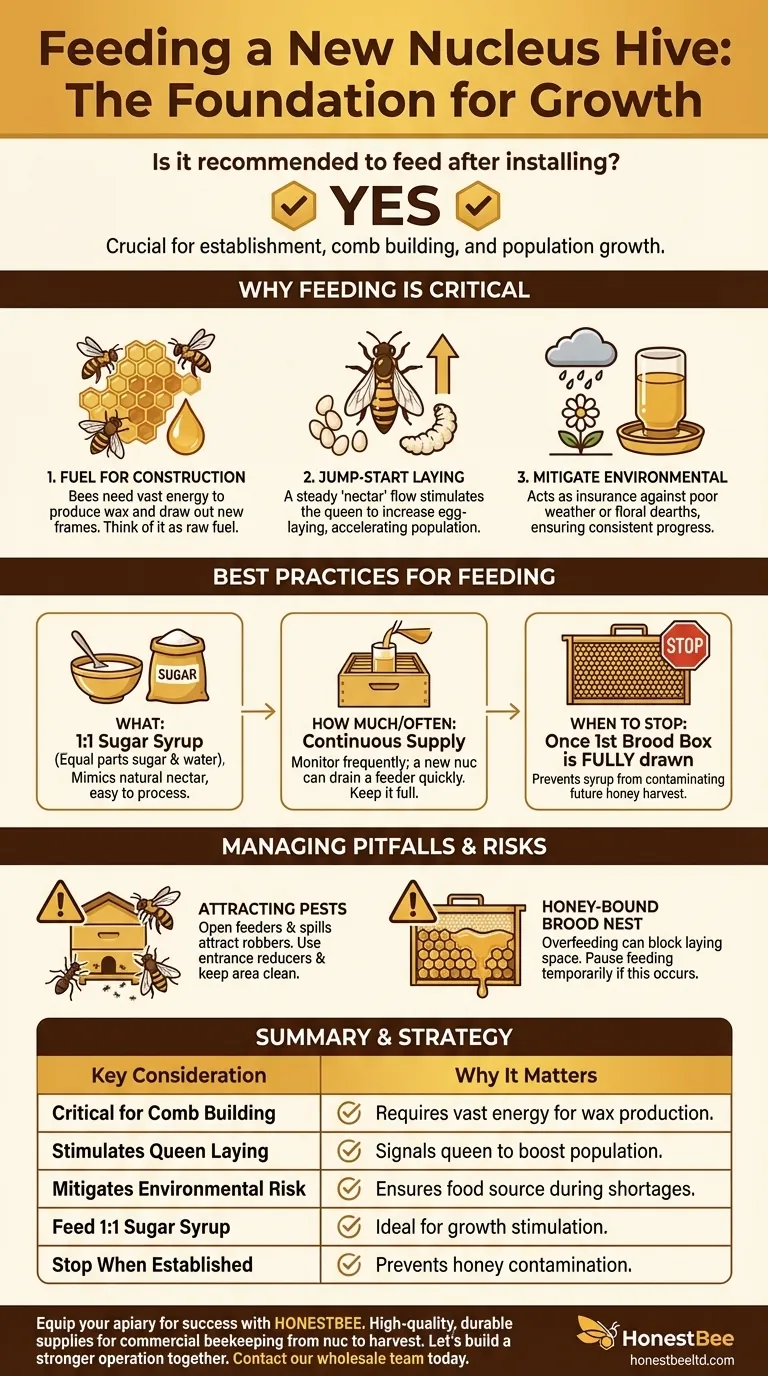In almost all circumstances, yes. Feeding a newly installed nucleus hive is a highly recommended and critical step for success. A nucleus hive, or "nuc," is a small, starter colony that needs a significant energy input to build wax comb, expand its population, and establish itself in the new, larger hive body. Supplemental feeding provides this essential energy, especially if natural nectar sources are scarce.
A nucleus hive has one primary job: to build out the remaining frames of the hive with new wax comb. Think of supplemental feeding not as a handout, but as the raw fuel required for this critical construction phase, bridging the gap until the colony is large enough to be self-sufficient.

Why Feeding is Critical for a New Nucleus
A nucleus hive arrives with a few frames of brood, honey, pollen, and a laying queen. However, it is fundamentally a colony with limited resources and a massive architectural task ahead of it.
The Energy Cost of Building Comb
Bees must consume vast amounts of nectar or sugar syrup to produce wax. The biological conversion rate is significant; bees need to consume many pounds of nectar to produce just one pound of wax.
Providing a steady supply of 1:1 sugar syrup gives them the raw carbohydrates needed to power their wax glands and begin "drawing out" the empty frames with fresh comb.
Jump-Starting the Queen's Laying
A strong, incoming flow of "nectar"—even if it's artificial syrup—is a powerful signal to the queen. It tells her that the colony has abundant resources to support new brood.
This stimulation encourages her to increase her egg-laying rate, accelerating the colony's population growth, which is essential for a strong and productive hive.
Mitigating Environmental Risk
You cannot always rely on the environment to provide for a new colony. A sudden cold snap, a period of rain, or a natural gap in blooming flowers (a "dearth") can halt a new colony's progress.
Supplemental feeding acts as an insurance policy, ensuring the bees have a consistent food source to continue their work regardless of outside weather conditions or floral availability.
Best Practices for Feeding a Nucleus Hive
How you feed is just as important as the decision to feed itself. Following established best practices ensures you are helping, not hindering, the colony.
What to Feed: 1:1 Sugar Syrup
The standard feed for stimulating growth is a 1:1 sugar syrup. This is made by mixing equal parts granulated white sugar and water (e.g., 5 lbs of sugar to 5 lbs of water).
This ratio closely mimics the sugar concentration of natural flower nectar, making it easy for the bees to process and use for comb building. Never feed honey from another hive, as it can transmit diseases.
How Much and How Often?
The goal is to provide a continuous supply. Use an entrance feeder or an in-hive feeder and keep it filled. The bees will take what they need.
Monitor the feeder every few days. If it's empty, refill it. A hungry nuc can drain a quart-sized feeder surprisingly fast, especially in the first couple of weeks.
When to Stop Feeding
This is the most critical part of the process. You should stop feeding for growth once the bees have built out all the frames in their first brood box.
Continuing to feed after this point can lead to them storing syrup in the honey supers you add later, contaminating your honey harvest. Once they are established, they should forage for themselves.
Understanding the Pitfalls and Trade-offs
While highly beneficial, feeding is not without its risks. Being aware of them allows you to manage the process effectively.
Risk of Attracting Pests
Open feeders and spilled syrup can attract ants, yellow jackets, and—most dangerously—robbing bees from other nearby hives. A robbing attack can quickly destroy a small nucleus colony.
To mitigate this, use an entrance reducer to make the hive easier for the nuc to defend, and be meticulous about keeping the area around the hive clean and free of spilled syrup.
Creating a "Honey-Bound" Brood Nest
If you feed too heavily and the queen can't keep up, the bees may start storing the syrup in the cells of the brood nest. This is called becoming "honey-bound" or "syrup-bound."
This leaves no room for the queen to lay eggs, which defeats the purpose of feeding. If you see this, you can temporarily pause feeding for a few days to allow the queen to catch up.
Making the Right Decision for Your Hive
Your feeding strategy should be guided by your primary goal and your local environment.
- If your primary focus is rapid colony growth and establishment: Feed a 1:1 syrup continuously until the first brood box is fully drawn with new comb.
- If you are in a very strong, natural nectar flow: You may feed less or not at all, but you must monitor the hive's comb-building progress. If they are slow to build, begin feeding immediately.
- If you are installing a nuc late in the season: Feed 1:1 syrup to get the comb built, then switch to a heavier 2:1 syrup (2 parts sugar to 1 part water) to help them build up their winter food stores.
By strategically managing their resources at this crucial stage, you empower your new colony to not just survive, but to thrive.
Summary Table:
| Key Consideration | Why It Matters |
|---|---|
| Critical for Comb Building | Bees need vast energy (sugar syrup) to produce wax and draw out new frames. |
| Stimulates Queen Laying | A steady food source signals the queen to increase egg-laying, boosting population. |
| Mitigates Environmental Risk | Acts as insurance against poor weather or nectar shortages. |
| Feed 1:1 Sugar Syrup | Mimics natural nectar, ideal for stimulating growth and comb construction. |
| Stop When Established | Cease feeding once the first brood box is fully drawn to prevent honey contamination. |
Equip your apiary for success with HONESTBEE.
Just as proper feeding is essential for a new nucleus hive, having the right, high-quality equipment is fundamental for long-term colony health and productivity. We supply commercial apiaries and beekeeping equipment distributors with the durable, reliable supplies needed to support every stage of beekeeping—from nuc installation to honey harvest.
Let's build a stronger beekeeping operation together. Contact our wholesale team today to discuss your equipment needs and how we can support your growth.
Visual Guide

Related Products
- HONESTBEE Round Hive Top Bee Feeder for Syrup
- HONESTBEE Entrance Bee Feeder Professional Hive Nutrition Solution for Beekeeping
- Rapid Bee Feeder White Plastic 2L Round Top Feeder for 8 or 10-Frame Bee Hives
- HONESTBEE Entrance Bee Feeder Efficient Hive Front Liquid Feeding Solution for Beekeeping
- Professional Hive Front Entrance Bee Feeder
People Also Ask
- What can the round hive top feeder be used for? A Guide to Efficient, Safe Bee Feeding
- What safety features are included in top feeders? A Guide to Drowning Prevention and Hive Safety
- How do you set up and use a top feeder for bees? A Step-by-Step Guide for Safe Feeding
- What features make top feeders a reliable choice for beekeepers? A Guide to Safe, Efficient Hive Nutrition
- How should syrup for bees be prepared? Master the Ratio for a Thriving Hive



















